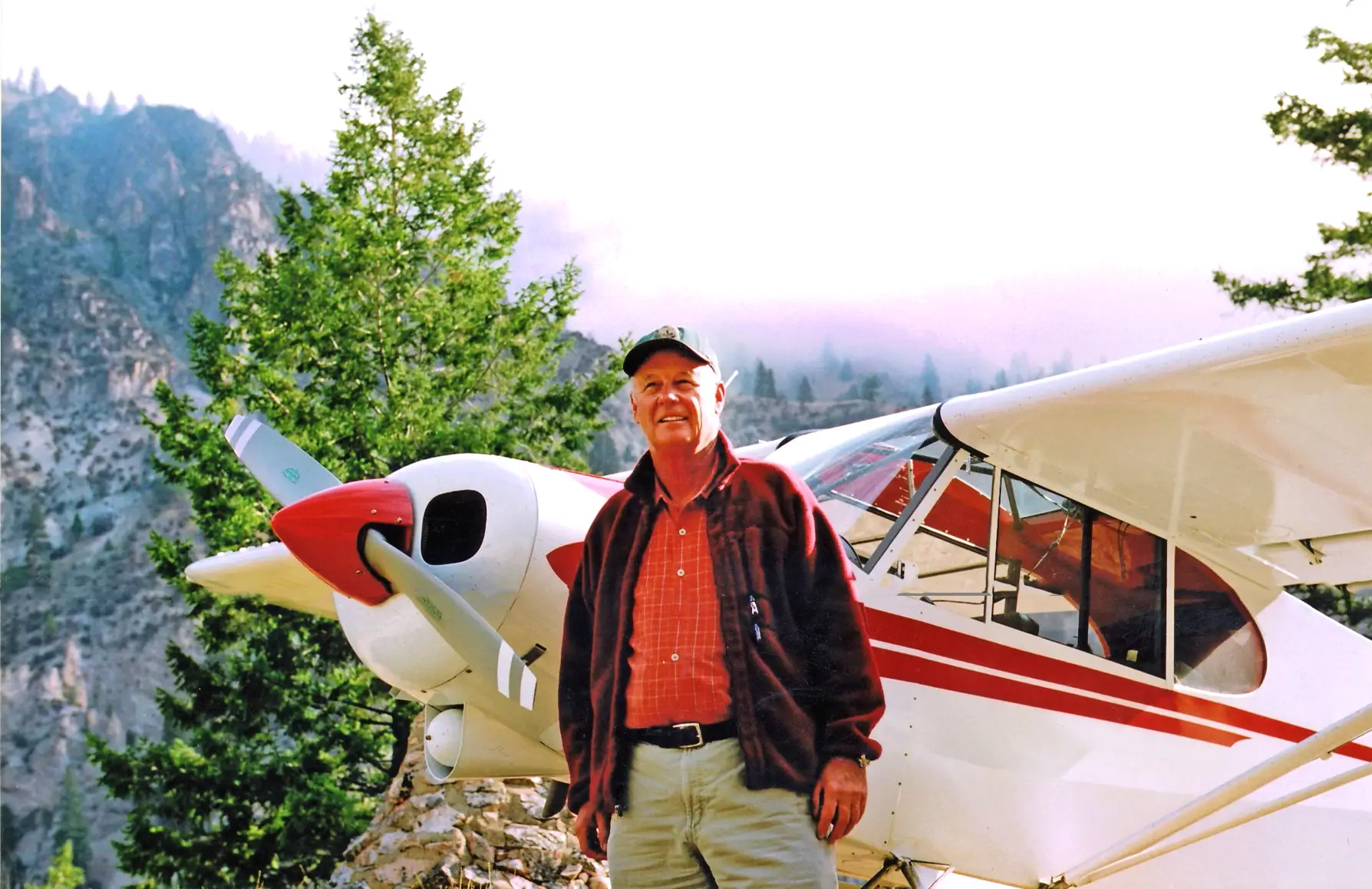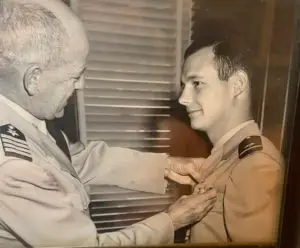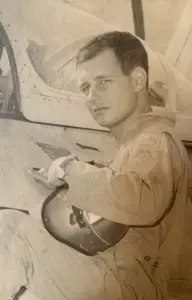
An accomplished flier, developer went on to champion canyonland, bighorn sheep
HAILEY, Idaho — Bob Stevens had a lifelong love affair with the sky. Anytime fair weather prevailed, he could be found aloft in the Idaho backcountry, at the yoke of his beloved Piper Cub.
It was there he found peace.
But for as much as Bob loved the clouds, he also loved the land.
If fact, he loved it so much that he would later give three years of his life to protect a large portion of the Owyhee Canyonlands from becoming a military bombing range.
Robert Gray Stevens, born April 9, 1935, passed away on Feb. 15 in Ketchum, Idaho after a brief illness.
He was 85.
While Stevens was born in Mount Vernon, New York; he and his younger brother, Tim, spent their formative years in rural Pennsylvania, outside of Philadelphia, against the picturesque backdrop of their parents’ pastoral farmland.
“In Philly, they call it a ‘gentleman’s farm,” explained Carol, Stevens’ wife of 52 years. “I think it was mostly farmed by others–it was typical rural Pennsylvania, with creeks and duck hunting and pheasants.”
Steven’s father worked in New York in the paper manufacturing business; his mother remained at home with the children.
After graduation from high school, Stevens came west to pursue a degree in geology at the University of Colorado at Boulder.
In 1956, he discovered the Boulder Municipal Airport. At the time, there were few aircraft based there, but plenty of opportunities to learn to fly.
Stevens felt obliged.
 By 1957, he soloed and was awarded his private pilot’s license.
By 1957, he soloed and was awarded his private pilot’s license.
This would be the beginning of his lifelong love of flying.
By June of that same year, Stevens entered the U.S Navy’s aviation program in Pensacola, Fla., serving as both a pilot and instructor, teaching young Naval aviators how to take off and land on aircraft carriers.
With his active-duty military commitment behind him, Stevens remained in the Navy Reserve for four years, attaining the rank of lieutenant junior grade. He moved to Denver in 1961 where he became a commercial airline pilot for the original Frontier Airlines, based out of then-Stapleton Airport.
Aspenglow
Colorado in the 1960s and ‘70s was a goldmine, in more ways than one. Clean air, pristine skiing, and burning blue skies drew tourists who eventually became residents.
And new residents needed condominiums.
Stevens realized this and saw more opportunity on the ground than he did in the sky.
So, he left his position at Frontier Airlines and headed to the sleepy little ski town of Aspen, Colo. where he would go on to become one of the most prominent and successful real estate developers in the area.
Aspen had a funky vibe, back then.
Popularized by John Denver’s hit song “Rocky Mountain High” it drew visitors from around the globe and quickly developed an eclectic international flavor.
According to his wife, Stevens spearheaded some of the first large-scale condominium projects in the area, and “Bob even helped write some of the Colorado legislation to enable that development.”
But ‘someone’ happened along the way.
Carol happened.
“Our mothers were best friends,” explained Carol. “But with there being 11 years between us, I never really knew Bob until I moved to Colorado in 1967.”
Tired of life in Philadelphia, Carol, too, packed up and moved west to glitzy Aspen where a handsome young developer was building condos.
“I was just sick of it and wanted out on my own,” she said. “So, when I got to Aspen, I looked him up and the romance began.”
Stevens, an avid skier, carried himself on a sturdy 5-foot-10-inch frame of Welsh descent. Clean-shaven, he had a thick head of dark brown hair and a smile that could easily wash across a crowded room—as well as a woman’s heart.
And it did.
The two married in Aspen in 1969.
“He was just a wonderful guy, kind, generous and kinda cute,” Carol said. “We did almost everything together.”
Well, almost everything.
Although the two had a lot in common, Carol said she was never interested in learning to fly.
“HE was the pilot,” she laughed. “I took lessons, and after about four hours I said, ‘I’m over this!’”
Although she flew almost everywhere with her husband, Carol refused to take the yoke. That was “his thing,” she said.
“Bob was an avid pilot,” she said, “In the summer of 1971, we took the Super Cub to British Columbia, put floats on it and spent a month flying around and living out of the plane.”
 Two years later, they did the same thing in Alaska with their Cessna 180.
Two years later, they did the same thing in Alaska with their Cessna 180.
Among Carol’s most memorable flying adventures were the trips she and Stevens took to their vacation home on the island of Carriacou, a small dependency of Grenada.
“We’d fly down after ski season and before Bob started another construction project,” she said. “It was our vacation.”
But in the mid-1970s, as Aspen began to grow, it also began to change.
Land came at a premium price and traffic was unbearable.
“Aspen became more glitzy,” Carol explained. “Well, it was always glitzy, but this was even more glitzy than before–and we wanted something more like what Aspen used to be.”
So, in 1977 the couple packed up and moved to Sun Valley, Idaho.
Almost a decade earlier, Stevens had purchased close to 20 acres north of Ketchum, and in the fall of 1978, he and Carol moved into their new family home.
And in 1982, they welcomed a son, Scott.
Ketchum, if you can
Ketchum was picture-perfect. Surrounded by breathtaking mountains, ample skiing and plentiful backcountry airstrips, Sun Valley was everything Stevens and his wife had dreamed of.
Opportunities for commercial office development abounded, and Stevens didn’t hesitate to take advantage.
He kept his plane at Friedman Memorial Airport where he noticed there weren’t any hangars to protect aircraft from the elements.
So what does a developer with an airplane at an airport with no hangars do?
Build some, of course.
It was supposed to just be six hangars, but according to Carol, there was such a demand, Stevens eventually completed a total of 35 hangars.
“The phone kept ringing and so he kept building,” she said. “Bob understood airports and he understood land use; he brought a lot of that with him from Aspen.”
For sheeps’ sake
Although many remember Stevens as an avid flier, he was also a formidable land conservationist.
Almost three decades ago, the U.S. Air Force had hopes of claiming hundreds of acres of pristine canyonland along the south fork of the Owyhee River for use as a military bombing range.
For Carol, she feels the Owyhee Canyonland victory was, without a doubt, the greatest accomplishment of her husband’s life.
“So many people float down that river, and enjoy the beauty, but few truly understand what happened for that to take place,” she said. “Bob dedicated three years of his life to protecting the land, and the wildlife.”
When neighboring Mountain Home Air Force Base went looking for additional land to build a new training range, they went looking along the Owyhees.
A 1994 High Country News article by Steve Steubner, Stevens is quoted saying, “If they wanted to pick the worst site, this is it.”
Fueled by politics, both at the local and federal level, Stevens joined an unlikely band of conservationists made up of game hunters, environmentalists and ranchers.
Carol emphasized the countless hours Stevens put in collaborating with members of the Duck Valley Indian Reservation, the 45 Ranch and The Nature Conservancy, an environmental organization that works to conserve the lands and waters upon which all life depends.
On Oct. 6, 1994, in the wake of beleaguered political flotsam, the U.S. Air Force did an about face and withdrew their interest in the Owyhee canyonlands.
“We made the decision to bring in The Nature Conservancy on the project because we have a long-standing interest in what happens to the California bighorn sheep in the Owyhee Canyonlands,” said Stevens, quoted in a Nov. 26, 1996 Associated Press news story. “We wanted to make sure they were protected, and we believe this is the best vehicle toward that end.”
It was a hard-won victory that paved the way for the majestic natural treasure that will be enjoyed for years to come.
Downwind
Stevens was a beloved fixture at Friedman Memorial Airport, flying two to three times a week, when the weather permitted.
Clad in his usual khaki slacks, a red checkered button-down shirt and his trademark lightweight fiberfill jacket, he was easily recognizable around the field.
As time claimed his once bushy head of hair, he added a ball cap to his “uniform of the day.”
Friedman Memorial Airport Manager Chris Pomeroy recalled his first encounter with Stevens, just shortly after he was hired.
“I can’t remember why Bob had ostensibly dropped by the office, but I quickly gathered he was there to ‘size-up the new guy’ that had just landed in the top position at his beloved airport,” said Pomeroy. “I could tell immediately he was definitely someone to be reckoned with–in a good way.”
Pomeroy said it didn’t take long for the two to connect.
“We shared stories about our careers in aviation, our mutual connections with the older Frontier Airlines, and of course, Bob’s time in Aspen,” he said. “As a Colorado native, I spent the first 35 years of my life and started my airport career there–all before moving to Idaho to chase a girl.”
Over the years, Pomeroy said Stevens became a good friend, as well as a mentor. His knowledge not only of aviation and development, but of the airport itself, helped the new airport manager start off on the right foot at Friedman.
“Whenever I had questions about certain aspects of Airport history, including dealing with people and organizations with money and power, Bob was always one of my first stops,” Pomeroy said.
He and Stevens would often reflect on how the airport had changed over the years.
“You know, you used to be able to walk across the highway and the runway to the hangars…and look at it now,’” Pomeroy said Stevens would quip. And then they’d laugh.
“In general, I just always looked forward to our conversations and his stories about the airport, his military flying career, and his hunting trips, especially his annual goose hunting trip to Canada,” Pomeroy added.
Stevens was an endearing fixture both on the ramp and in the pattern. “There goes Bob,” or “Bob’s back…” were common statements from the airport staff. Even during the busiest of times, N10DU could be heard among the heavy iron of Sun Valley’s glamorous Allen & Company week.
“When the majority of local pilots concede the week to the heavy iron, Bob wanted to fly, and gosh darn it, he was going to fly.” Pomeroy said. “In the midst of Global Expresses and Gulfstream 650s all over the airspace, you’d hear the tower say, “N10DU, clear for takeoff” or “clear to land.” “We got a kick out of it,” added Pomeroy.
Stevens practiced yoga, almost every morning.
He and Pomeroy had a running joke.
“He used to say, ‘At my age, Chris, how else am I going to be able to get in and out of that Cub if I don’t do my yoga?’”
Again, the two would laugh.
An accomplished flier, Stevens gave generously of his time, skill and plane to the community and to countless search and rescue missions.
For many, the KSUN pattern will never be the same without a particular white and red Piper Cub.
“When I broke the news about Bob to our tower manager, there was a few seconds of silence followed by some sadness, ‘we’ve been asking ourselves, where has Bob been?’” Pomeroy said.
“About two months ago, the phone rang, and it was Bob,” said Pomeroy, “He wanted me to hop in the Cub with him for quick flight.”
He thanked Stevens but declined his offer due to multiple meetings and other airport obligations.
“I wish I would have gone.”
There were few lives in the valley on which Stevens did not have an impact.
He will be sorely missed.
“Bob lived his life on his own terms,” said Carol. “He used to say, ‘People die like they live—and Bob lived his life the way he wanted.”
Follow your heart and do what you want, she said.
And Stevens’ heart wanted to fly—it was “his life.”
“Especially as he got older,” Carol surmised, “For Bob flying was everything. For me, it was time with Bob.”
Stevens was loved by airport staff.
Heartbroken, to lose such a kind, good man, friend, and advocate for the airport, Stevens will always be remembered fondly.
“Thank you, Bob, for your friendship and mentorship—and of course, the goose sausage,” said Pomeroy. “We will miss you. May you always have blue skies and tailwinds on your next flying adventures.”
In accordance with his personal wishes, there will be no memorial service for Stevens. In lieu of flowers, the family requests donations be made to:
The Hospice of Wood River Valley
P.O, Box 4320
Ketchum, ID 83340
https://hpcwrv.org/donate

